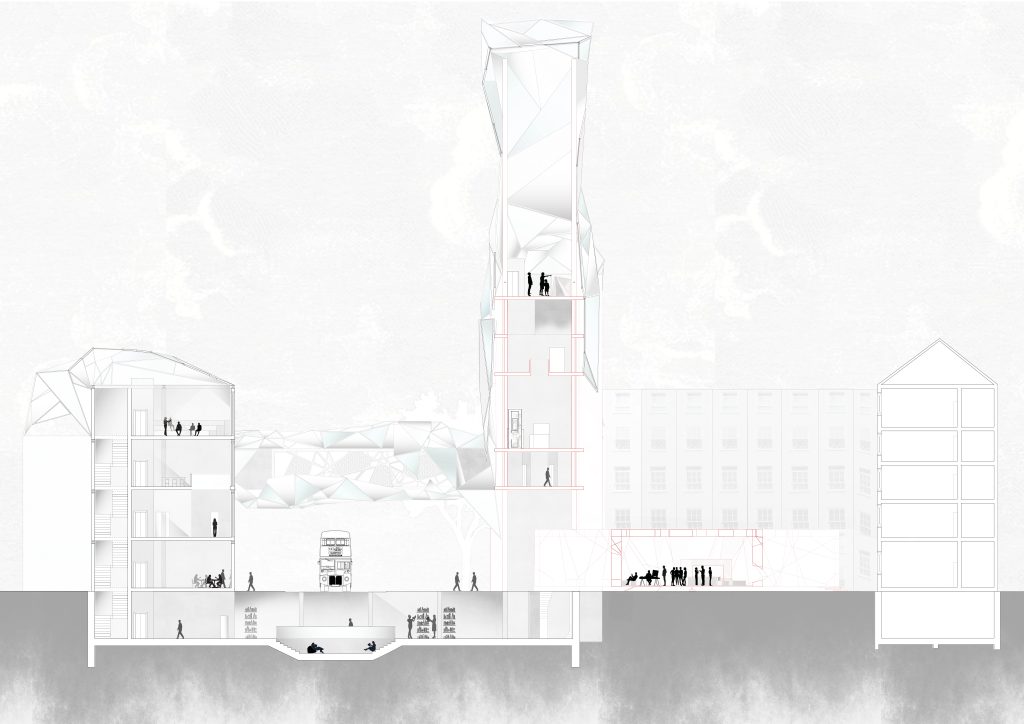Co-Authoring Culture: Veronia Abdelshehid’s Hyperbook Market and Theatre in King’s Cross
Reimagining the Public Life of Literature in the Heart of London
If King’s Cross is London’s perennial canvas of creativity, then Veronia Abdelshehid’s final-year project paints a bold new narrative upon it. A recent BA (Hons) Architecture graduate from the University of Westminster and RIBA Part 1 recipient, Abdelshehid’s academic journey is defined by projects that challenge conventions with social purpose and creative insight. Her latest venture, The Citizen’s Hyperbook Market and Theatre, reframes the relationship between architecture, literature, and the people who animate both: the citizens themselves.
From Monument to Movement: A Counterpoint to the Library Tower
Abdelshehid’s site selection is itself a charged gesture—a move away from the imposing singularity of the British Library’s King’s Library Tower, to the more intimate, overlooked courtyard of Levita House. “The prevailing library architecture enshrines knowledge at a distance,” Abdelshehid reflects, alluding to the vertical, almost fortress-like symbolism of the British Library’s tower. Her project proposes a radical alternative: a porous, interconnected marketplace of stories, learning, and performance, where knowledge is owned and reinvented by all.
Architectural Narrative: Three Spaces, One Lifespan
At the heart of the Citizen’s Hyperbook Market and Theatre is the idea that literature is not a static artifact, but a living, breathing phenomenon—born and reborn through interaction and interpretation. Abdelshehid materialises this concept with a suite of three buildings:
-
The Market: Far from a conventional bookshop, the market is a bustling forum where books, zines, and pamphlets are bartered, traded, or self-published. Market stalls double as mini-exhibition spaces, hosting workshops led by local writers and artists. It’s a direct challenge to the commodification of literature—a place for literary exchange as a communal act.
-
The Theatre: Moving from the spoken to the performed word, the adjacent theatre is a deliberately mutable space. Retractable seating, movable partitions, and modular sets support everything from traditional plays to experimental readings or communal storytelling sessions. Audience and performer merge: stories evolve with each retelling, and ‘liveness’ is built into the building’s bones.
-
The Communal Hub: The journey culminates in an underground passage linking to a communal hub—a locus for reflection, debate, and collective authorship. Here, digital and analog technologies converge: writable walls, sound booths, and editing suites blur the boundary between reader and writer, producing new ‘hyperbooks’ that riff off public input.
A Bridge and a Passage: Architecture as Metaphor
Abdelshehid’s narrative is reinforced by physical interconnection: a symbolic bridge in the courtyard stitches together the market and theatre, referencing both the genealogy of literary texts and the act of collaborative ‘crossing over’ from tradition to reinvention. The underground passage deepens this metaphor, inviting visitors to move—both literally and philosophically—beneath the surface of the familiar and into territory where all voices matter.
Form, Materiality, and Social Responsibility
Materially, the project steers clear of the monumental. Reclaimed brick, exposed timber, and translucent polycarbonate create a sense of informality and approachability—mirroring the inclusivity of its ethos. Facades open directly onto the courtyard, dissolving barriers between interior and city, and signalling that participation isn’t just welcomed, but necessary.
In a nod to sustainability and Abdelshehid’s previous explorations of food waste and homelessness, the communal hub incorporates adaptive seating, bookshelves made from surplus materials, and even a community kitchen. “Architecture shouldn’t just shelter culture; it should cultivate it,” she remarks—a philosophy echoed across her internship experiences and mentoring roles.
Recognition and Impact
The Citizen’s Hyperbook Market and Theatre doesn’t just reinterpret a typology; it challenges the very framework of how knowledge is shared and who is allowed to shape it. While the scheme is firmly rooted in the particulars of King’s Cross, its implications travel far: every city needs spaces where creative agency is returned to its citizens.
Abdelshehid’s project was lauded by tutors for its clarity of vision and deft handling of complex spatial narratives. External reviewers singled out the proposal’s careful integration of public process and design, along with its challenge to memory and authority in the urban context. The Hyperbook Market and Theatre stands as a testament to Abdelshehid’s commitment to socially responsive design—melding critical enquiry with tangible solutions.
Connect with Veronia Abdelshehid
Veronia’s work is always open to dialogue, collaboration, and new perspectives. For those interested in socially engaged architecture, transformative cultural projects, or even just to share a story, she can be reached via:
- LinkedIn: Veronia Abdelshehid
- Email: vabdelshehid@gmail.com
- Instagram: @va.archjourney
Whether exchanging ideas over digital platforms or joining future participatory projects, engaging with Abdelshehid promises not just architectural discourse, but genuine co-authorship—the very spirit of the Hyperbook brought to life.












Add a comment